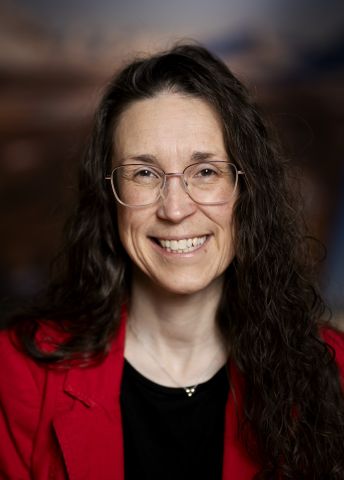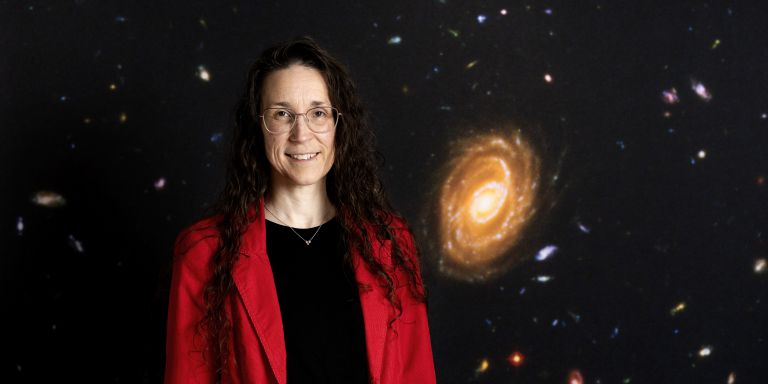
Kirsten Kraiberg Knudsen
Professor of Astronomy
Wallenberg Scholar 2024
Institution:
Chalmers University of Technology
Research field:
The formation and evolution of galaxies


Wallenberg Scholar 2024
Institution:
Chalmers University of Technology
Research field:
The formation and evolution of galaxies
The distances are extreme and the timescales dizzying. Knudsen, professor of astronomy at Chalmers University of Technology, is studying the evolution of the universe on cosmological scales, meaning as far into space as it is currently possible to see. These far reaches of space are home to massive galaxies with stars formed during the first epoch of the universe, 2–3 billion years after the Big Bang.
“What we see today is the result of events from very long time ago. I’m studying massive galaxies far beyond the Milky Way and our neighboring galaxies. When we study such distant objects, we also look back in time,” she says.
Studying the very earliest evolution is crucial for understanding why the universe is as it is today. Knudsen points to a diagram illustrating the first galaxies after the birth of the universe, explaining that the early universe saw intense activity that later subsided.
“In that phase, there were many collisions and interactions between galaxies. The supermassive black holes at their centers grew rapidly; there was more gas in galaxies, and many new stars were formed. Since then, the growth of supermassive black holes has tapered off. There’s less gas – needed for new stars to form – and not as much activity in galaxies,” she says.
Over the next few years Knudsen intends to discover more about the origins of the most distant galaxies. Her aim is to understand the mechanisms behind the evolution of massive galaxies and the formation of stars in them. Her research team will examine both what happens inside galaxies and in their surroundings.
Understanding how the universe works helps us understand our origins. That has always fascinated me.
“We know very little about what exists around massive galaxies and how this affects their development. What types of galaxies are nearby, and what is the effect of gas flow from them? By the end of the project, I hope we’ll also be able to describe and measure how much energy a growing massive black hole injects into its galaxy. These are some of the questions we’re seeking to answer so we can gain a better understanding of the evolution of massive galaxies,” she says.
The researchers will be developing new methods, including ways of detecting and characterizing gas-rich galaxies around massive ones. Observations are being conducted using the powerful ALMA telescope in Chile, which allows observations to be made deep into the universe at a previously inconceivable level of detail.
Knudsen stresses the enormous technological advancements in the field:
“When I was a student in the 1990s we debated whether the universe was created 10 or 20 billion years ago. We now know that it is 13.8 billion years old, and our measurements are much more precise,” she says.
As new methods and increasingly sensitive tools are developed, Knudsen believes the limits of how far back we can go will be extended even farther.
“New radio telescopes are being developed, and the discoveries we’ve already made serve as a basis for new questions. The better tools we have, the greater our ability to observe smaller or less distinct objects, giving us a more comprehensive picture. In 10–20 years I think our observations will have come so close to the Big Bang that we will be able to meaningfully describe the very first galaxies,” she says.
From an early age Knudsen was captivated by the many questions and mysteries that the universe harbors. Halley’s Comet passed Earth In 1986, when she was ten, and during her childhood she devoured all news about space discoveries, advancements and events.
“The universe is vast, abstract and distant, involving scales far beyond the everyday. Understanding how the universe works helps us understand our origins. That has always fascinated me,” she says
As a researcher, she is happiest when exciting new data arrive or the research team makes a new discovery.
“I enjoy all the collaborations involved in research and the interactions with colleagues working in the same ‘ecosystem.’ I also really enjoy working with younger colleagues and seeing their joy when they succeed in their research,” she says.
Grants from Knut and Alice Wallenberg Foundation have created many opportunities over the years, enabling her to establish a solid foundation in her field.
“The grants are a great honor and essential if I am to realize my ideas. I’ve had the opportunity to build a research team that has achieved a great deal, and together we’ve positioned ourselves among the world leaders in this field,” she says.
Tex Ulrika Ernström
Translation Maxwell Arding
Photo Johan Wingborg